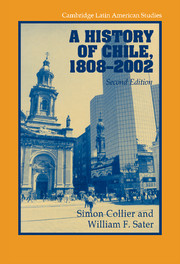Book contents
- Frontmatter
- Contents
- List of maps
- Preface to the Second Edition
- A note on geography
- CAMBRIDGE LATIN AMERICAN STUDIES
- PART I Birth of a nation-state, 1800s–1830s
- PART II The rise of a republic, 1830s–1880s
- PART III The nitrate era, 1880s–1930s
- PART IV Industrial advance and the dawn of mass politics, 1930s–1960s
- PART V Democracy and dictatorship, 1960s–2000s
- 11 Revolution in liberty, 1964–70
- 12 The Chilean road to socialism, 1970–73
- 13 The Pinochet years
- 14 Re-encounter with history, 1990–2002
- Glossary of Spanish terms
- Initials and acronyms
- Further reading
- Index
13 - The Pinochet years
Published online by Cambridge University Press: 05 June 2012
- Frontmatter
- Contents
- List of maps
- Preface to the Second Edition
- A note on geography
- CAMBRIDGE LATIN AMERICAN STUDIES
- PART I Birth of a nation-state, 1800s–1830s
- PART II The rise of a republic, 1830s–1880s
- PART III The nitrate era, 1880s–1930s
- PART IV Industrial advance and the dawn of mass politics, 1930s–1960s
- PART V Democracy and dictatorship, 1960s–2000s
- 11 Revolution in liberty, 1964–70
- 12 The Chilean road to socialism, 1970–73
- 13 The Pinochet years
- 14 Re-encounter with history, 1990–2002
- Glossary of Spanish terms
- Initials and acronyms
- Further reading
- Index
Summary
Not a leaf stirs in Chile without me moving it.
– General Augusto Pinochet (1981)Consolidation of the Pinochet regime
September 11, 1973 – el once, “the eleventh,” as Chileans simply called it for years afterward – represented the worst political breakdown in the history of the republic. Perhaps because the level of national desperation had reached such heights in 1973, the aftermath was far more prolonged than anyone would have believed possible. At the end of July 1989, General Augusto Pinochet broke the previous record for length of tenure among Chilean rulers (all since 1540) – until then held by Governor Gabriel Cano de Aponte at fifteen years, ten months (1717–33). By the time he left office, Pinochet had ruled Chile for eight months longer than his colonial predecessor.
The iron heel of ruthless repression was stamped down from the first moments of the new regime. Congress was closed. The UP parties were banned, other parties placed “in recess” – until 1977, when they too were banned. A strict night-time curfew was imposed and not lifted for several years. Left-wing newspapers and magazines vanished from the kiosks. The public administration was extensively purged. In the opening phase of the regime, virtually all important national institutions (including the soccer federation) were assigned to generals or admirals, colonels or captains, some of them hauled out of retirement. In the universities (also extensively purged), uniformed “delegate-Rectors” took over. The atmosphere of Chile was transformed overnight.
- Type
- Chapter
- Information
- A History of Chile, 1808–2002 , pp. 359 - 389Publisher: Cambridge University PressPrint publication year: 2004

